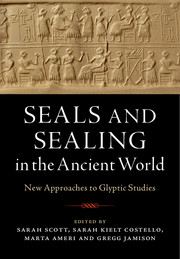 Seals and Sealing in the Ancient World
Seals and Sealing in the Ancient World Book contents
- Seals and Sealing in the Ancient World
- Seals and Sealing in the Ancient World
- Copyright page
- Contents
- Notes on Contributors
- Illustrations
- Plates
- Tables
- Acknowledgments
- Preface
- Abbreviations
- Chapter One Introduction: Small Windows, Wide Views
- Part I The Ancient Near East and Cyprus
- Part II South Asia and the Gulf Region
- Chapter Eight Indus Seals and Glyptic Studies: An Overview
- Chapter Nine Letting the Pictures Speak: An Image-Based Approach to the Mythological and Narrative Imagery of the Harappan World
- Chapter Ten Understanding Indus Seal-Carving Traditions: A Stylistic and Metric Approach
- Chapter Eleven Operational Sequences and Stamp Seals: A Preliminary Report on an Experimental and Microtopographic Framework for Identifying Groups of Seal Carvers in the Indus Civilization
- Chapter Twelve Seals and Sealing Technology in the Dilmun Culture: The Post-Harappan Life of the Indus Valley Sealing Tradition
- Part III Egypt
- Part IV Aegean
- References
- Endnotes
- Index
Chapter Twelve - Seals and Sealing Technology in the Dilmun Culture: The Post-Harappan Life of the Indus Valley Sealing Tradition
from Part II - South Asia and the Gulf Region
Published online by Cambridge University Press: 24 April 2018
- Seals and Sealing in the Ancient World
- Seals and Sealing in the Ancient World
- Copyright page
- Contents
- Notes on Contributors
- Illustrations
- Plates
- Tables
- Acknowledgments
- Preface
- Abbreviations
- Chapter One Introduction: Small Windows, Wide Views
- Part I The Ancient Near East and Cyprus
- Part II South Asia and the Gulf Region
- Chapter Eight Indus Seals and Glyptic Studies: An Overview
- Chapter Nine Letting the Pictures Speak: An Image-Based Approach to the Mythological and Narrative Imagery of the Harappan World
- Chapter Ten Understanding Indus Seal-Carving Traditions: A Stylistic and Metric Approach
- Chapter Eleven Operational Sequences and Stamp Seals: A Preliminary Report on an Experimental and Microtopographic Framework for Identifying Groups of Seal Carvers in the Indus Civilization
- Chapter Twelve Seals and Sealing Technology in the Dilmun Culture: The Post-Harappan Life of the Indus Valley Sealing Tradition
- Part III Egypt
- Part IV Aegean
- References
- Endnotes
- Index
Summary
The seals and sealing of the Dilmun Culture represent one of the most understudied glyptic traditions of the old world. Based on the extant data from the Early Dilmun period (ca. 2250–1650 BCE) the present contribution provides an introduction to the all-pervasive “Gulf” and “Dilmun Type” stamp seals and evaluates the range of their chronological and geographical distribution. Above all, Bronze Age Dilmun is seen as a key context for understanding the sealing traditions of the Old World because it represents a melting pot in which hybrid forms of glyptic art developed under the influence of her major trade partners in the Indus Valley, Babylonia, and beyond. In the present study, rectangular Dilmun seals and cylinder seals carved in the Dilmun style are investigated as cardinal examples in Dilmun art of such creative translations. The study additionally introduces evidence that applies to the symbolic and practical function of the seals as bureaucratic devices in an ideological and administrative system. The latter includes impression on sealings and cuneiform tablets but also addresses a small group of so-called tokens stamped with Dilmun-related seals, and sealing symbolism expressed on pottery vessels.
- Type
- Chapter
- Information
- Seals and Sealing in the Ancient WorldCase Studies from the Near East, Egypt, the Aegean, and South Asia, pp. 204 - 226Publisher: Cambridge University PressPrint publication year: 2018
- 2
- Cited by
